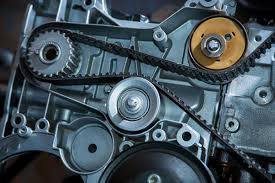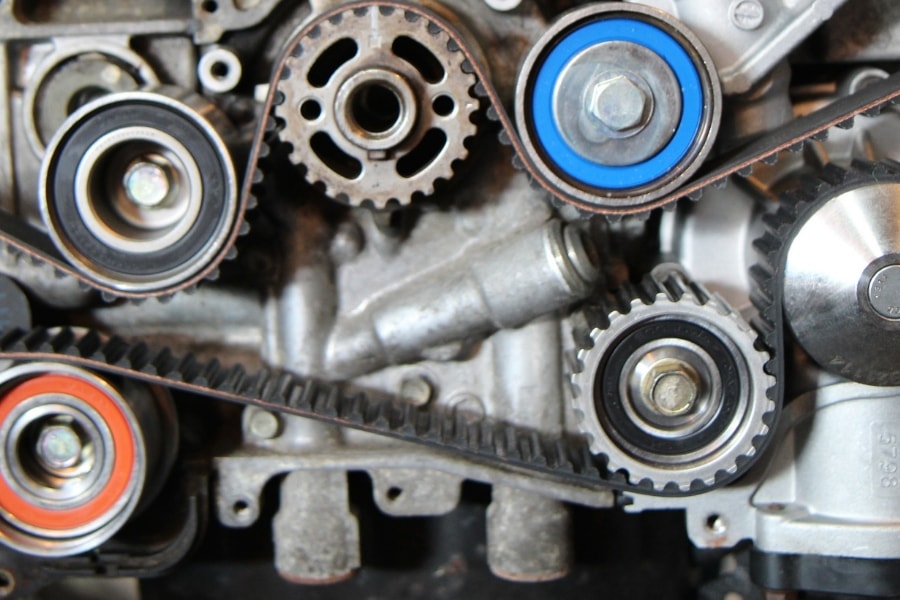Your engine is a carefully synchronized system, and one of the most critical components keeping everything running in harmony is the timing belt. Over time, this belt wears down, and if it breaks, it can cause catastrophic engine damage. That’s why timing belt replacement is one of the most important pieces of preventative maintenance for your vehicle.
In this guide, we’ll explain what a timing belt does, when to replace it, signs of a worn timing belt, and how much replacement typically costs.
🔧 What Is a Timing Belt?
The timing belt, sometimes called a cam belt, is a durable rubber belt with teeth that synchronizes the rotation of the crankshaft and the camshaft(s). This ensures that the engine’s valves open and close at the right times during each cylinder’s intake and exhaust strokes.
📌 Key Functions:
- Maintains precise timing between the engine’s moving parts.
- Controls the opening and closing of engine valves.
- Keeps the pistons and valves from colliding (in interference engines).
🚨 Why Timing Belt Replacement Is Critical

Unlike other belts in your car, the timing belt is not visible during regular inspections. If it snaps while the engine is running, it can cause serious internal damage, including:
- Bent valves
- Damaged pistons
- Ruined cylinder head
- Complete engine failure
Regular replacement prevents unexpected breakdowns and expensive repairs.
⏳ When Should You Replace the Timing Belt?
Most manufacturers recommend timing belt replacement between 60,000 and 100,000 miles (or every 5–7 years), but this varies by vehicle make and model.
📘 Always check your owner’s manual for:
- Recommended mileage/time intervals
- Whether your car uses a timing belt or chain (chains typically last longer)
⚠️ Signs Your Timing Belt Needs Replacement
Although timing belts don’t often show visible signs of wear, here are some common symptoms:
- 🔊 Ticking or rattling noise from the engine
- 🚫 Engine won’t start or misfires
- 🔻 Loss of power or rough idling
- 🚨 Oil leaking from the front of the engine
- 📈 Check Engine Light illuminated
If you notice any of these signs, have your timing belt inspected immediately.
💰 Timing Belt Replacement Cost
The cost of replacing a timing belt varies widely depending on the vehicle’s make, model, and engine design.
💵 Average Cost:
- $300 – $800 for most vehicles
- $1,000+ for high-performance or interference engines (may include water pump replacement)
Many shops recommend replacing the water pump, tensioners, and idler pulleys at the same time, since they share the same labor.
🛠️ What’s Included in a Timing Belt Replacement?

A full timing belt service usually includes:
- New timing belt
- New tensioner(s)
- Idler pulleys
- Water pump (optional but recommended)
- Coolant flush (if water pump is replaced)
This ensures all related components are fresh and reduces the chance of future failure.
🧰 Can I Replace a Timing Belt Myself?
While a skilled DIY mechanic can replace a timing belt, it’s a complex and time-consuming job that requires precision. Mistakes can damage the engine, so it’s often best left to professionals unless you have experience with engine timing.
✅ Tips to Extend Timing Belt Life
- 🧼 Keep up with routine maintenance (oil changes, coolant flushes)
- 🔎 Check for oil or coolant leaks near the timing cover
- 🧊 Replace the water pump if it shows signs of wear
- 🔧 Follow your vehicle’s service intervals strictly
FAQs About Timing Belt Replacement
Q1: What happens if I don’t replace my timing belt?
It can snap without warning, potentially causing severe engine damage, especially in interference engines.
Q2: How long does timing belt replacement take?
Typically 3–6 hours, depending on the engine layout and if additional components like the water pump are replaced.
Q3: Can a timing belt cause engine misfires?
Yes, if it’s slipping or misaligned, it can disrupt valve timing and cause misfires.
Q4: How do I know if my car has a timing belt or chain?
Check your owner’s manual or ask a mechanic. Generally, older vehicles use belts, while many modern ones use chains.
Q5: Should I replace the water pump with the timing belt?
Yes, especially if they’re driven by the same belt. It saves on labor and prevents future issues.
Q6: Can a broken timing belt damage my engine?
Absolutely. In interference engines, it often causes bent valves, damaged pistons, or worse.
Q7: Does timing belt replacement improve performance?
It won’t increase horsepower, but it will restore smooth, reliable engine operation and prevent breakdowns.
Q8: Is it okay to delay timing belt replacement?
No. Delaying can result in sudden failure and potentially thousands of dollars in engine damage.
Conclusion: Don’t Delay Timing Belt Replacement
Your timing belt is a silent hero—keeping your engine running smoothly and in perfect sync. Replacing it on time is one of the most important ways to protect your engine and avoid catastrophic failure. By staying on top of your vehicle’s maintenance schedule, you can ensure peace of mind and extend your car’s life for years to come.




